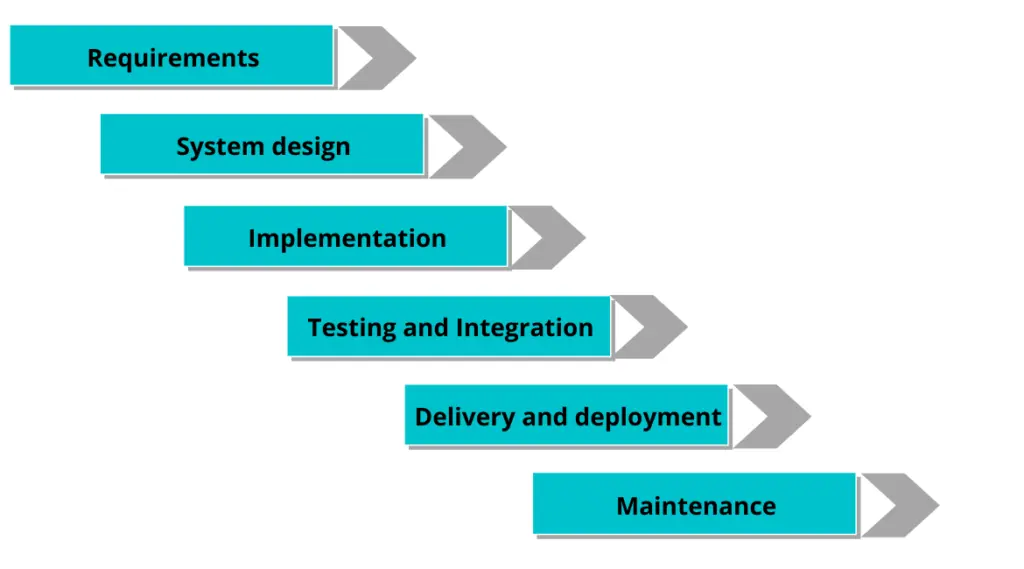blog
December 09, 2020
•5 min read
The Waterfall model: Advantages and disadvantages
What is the Waterfall Model?
Coming about in the 1970’s, Waterfall is a project development model that is used in many industries. It was the first project model to be used in the software development lifecycle (SDLC). In the software world, it was widely used until the advent of Agile methods. Though Agile is now the star of the show, Waterfall remains one of the most popular design models. Waterfall is a step-by-step operation plan, where each step must be completed before moving onto the next. This is referred to as a linear sequential lifecycle model.
Phases in Waterfall
There are six phases in the Waterfall system, and each is designed to flow intuitively into the next. While this is used in many other types of creation, it has been very effective for certain types of software development. Let’s break down each of the steps, and what they entail.

Requirements
First, the software team gets all the requirements from the client. They must make sure to be extremely thorough, and have a clear vision for the end product, because it is quite difficult to change things later. Requirements include its function, purpose, and unique specifications.
System design
The next phase is system design, during which the architect and the senior members of the team create the framework for the software. After hardware and software specifications are defined, they write all the necessary code. Then it’s time to move to the next step.
Implementation
Once the blueprints are done, it’s time for the developers to create the software in small pieces, called units. Each unit is individually developed and then tested, in what is called ‘unit testing’. Each unit must be fully functional before moving forward.
Testing and Integration
During this period, all of the units are combined into a system, which will eventually be the final product. The team tests the system, making sure all the units work together properly. Any defects are resolved as they arise.
Delivery and deployment
When all the kinks are worked out, it’s time to deliver the software. The team installs the system, runs tests on the servers, and then the software goes into use. During this initial launch period, the team is on standby to monitor the software’s functionality.
Maintenance
After the software goes live, the developers may make modifications or other slight changes upon the client’s request. Any defects that arise or those that were missed in the previous stages are also fixed. As time goes on, the client is provided with regular support and maintenance.
Pros of the Waterfall Model
Though praised and criticized alike, there are reasons why Waterfall remained so popular for so many years, and is still in use today. Here are some of the benefits of implementing this method into software development.
- Easy to use
As mentioned above, Waterfall is a very smooth and natural development process. Because it is linear, there aren’t too many aspects to monitor at once. Teams don’t require any extra training to use this method, either. When using the Waterfall Model, the software you’re creating should be already known to the team. This also counteracts the potential need for outsourced developers.
- More control
Deadline estimates are most more concrete when using Waterfall, because each phase is completed entirely before moving on to the next one. Of course, there are unforeseen circumstances that may cause delays, as with any project, but with Waterfall, the timeline fluctuates less because of the rigid procedures.
Cons of the Waterfall Model
As technology grows more complex, so do our software needs. Waterfall was great for developing software when things were not so complicated, but over the past decade or two, new downfalls have emerged.
- Not dynamic
Once any of the stages have been completed, it is quite difficult to go back to make changes. So, before implementing Waterfall, one must be sure that the end goal is finalized. Because of how difficult it is to go backwards, Waterfall is not suited to complex or ongoing projects. The best fit for this method is definitely the software that is simple, and doesn’t have too many moving pieces.
- Lacking feedback
Because the delivery stage is so far along in the process, the client does not get any working software until everything is completed. This may cause issues if the client wants or needs more frequent updates, or if they want to see measurable progress. Waterfall is good for projects that don’t require much client involvement.
- Late testing periods
The phases of Waterfall, as mentioned above, do not start testing until fairly late in the development process. While this is okay when the software works, problems arise when the software has defects. It is difficult to go back and find the source of the problem when so much of the project is already integrated, and takes a lot longer than small incremental development testing.
Waterfall Model vs. Agile Methods
There are many differences between Waterfall and Agile methods. Here are some of the most relevant ones.
Waterfall Model
Agile Methods
Needs precise and long term planning, requirements are usually static
Short term planning is okay, requirements are dynamic
Has a strong hierarchical team structure
Each team member has an equal role
Not dependant on client communication
Constant client communication
Quality control can be difficult, because of late testing
Quality control is checked through consistent testing
Progress is measured by the steps that are completed
Progress is measured by unit or sprint completion
Deadlines can be determined well, provided no major problems arise
Deadlines of deliverables can change if the requirements change
Better for short, simpler projects
Projects can be complex, ongoing, and long-term
Read more detailed overview in What are the differences between Agile and Waterfall? article.
At Blocshop, we use four different Agile methods, led by certified Agile practitioners. We believe that these methods are the best way to meet the highest standards, in the most efficient way. Whether it is an ongoing project, or starting from the ground up, we are committed to providing excellent service. To learn more about how we would fulfill the needs of your company, contact us here.
Learn more from our insights

NOVEMBER 3, 2025 • 7 min read
CE marking software under the EU AI Act – who needs it and how to prepare a conformity assessment
From 2026, AI systems classified as high-risk under the EU Artificial Intelligence Act (Regulation (EU) 2024/1689) will have to undergo a conformity assessment and obtain a CE marking before being placed on the EU market or put into service.

October 19, 2025 • 7 min read
EU and UK AI regulation compared: implications for software, data, and AI projects
Both the European Union and the United Kingdom are shaping distinct—but increasingly convergent—approaches to AI regulation.
For companies developing or deploying AI solutions across both regions, understanding these differences is not an academic exercise. It directly affects how software and data projects are planned, documented, and maintained.

October 9, 2025 • 5 min read
When AI and GDPR meet: navigating the tension between AI and data protection
When AI-powered systems process or generate personal data, they enter a regulatory minefield — especially under the EU’s General Data Protection Regulation (GDPR) and the emerging EU AI Act regime

September 17, 2025 • 4 min read
6 AI integration use cases enterprises can adopt for automation and decision support
The question for most companies is no longer if they should use AI, but where it will bring a measurable impact.
The journey to your
custom software
solution starts here.
Services
Let's talk!
blog
December 09, 2020
•5 min read
The Waterfall model: Advantages and disadvantages
What is the Waterfall Model?
Coming about in the 1970’s, Waterfall is a project development model that is used in many industries. It was the first project model to be used in the software development lifecycle (SDLC). In the software world, it was widely used until the advent of Agile methods. Though Agile is now the star of the show, Waterfall remains one of the most popular design models. Waterfall is a step-by-step operation plan, where each step must be completed before moving onto the next. This is referred to as a linear sequential lifecycle model.
Phases in Waterfall
There are six phases in the Waterfall system, and each is designed to flow intuitively into the next. While this is used in many other types of creation, it has been very effective for certain types of software development. Let’s break down each of the steps, and what they entail.

Requirements
First, the software team gets all the requirements from the client. They must make sure to be extremely thorough, and have a clear vision for the end product, because it is quite difficult to change things later. Requirements include its function, purpose, and unique specifications.
System design
The next phase is system design, during which the architect and the senior members of the team create the framework for the software. After hardware and software specifications are defined, they write all the necessary code. Then it’s time to move to the next step.
Implementation
Once the blueprints are done, it’s time for the developers to create the software in small pieces, called units. Each unit is individually developed and then tested, in what is called ‘unit testing’. Each unit must be fully functional before moving forward.
Testing and Integration
During this period, all of the units are combined into a system, which will eventually be the final product. The team tests the system, making sure all the units work together properly. Any defects are resolved as they arise.
Delivery and deployment
When all the kinks are worked out, it’s time to deliver the software. The team installs the system, runs tests on the servers, and then the software goes into use. During this initial launch period, the team is on standby to monitor the software’s functionality.
Maintenance
After the software goes live, the developers may make modifications or other slight changes upon the client’s request. Any defects that arise or those that were missed in the previous stages are also fixed. As time goes on, the client is provided with regular support and maintenance.
Pros of the Waterfall Model
Though praised and criticized alike, there are reasons why Waterfall remained so popular for so many years, and is still in use today. Here are some of the benefits of implementing this method into software development.
- Easy to use
As mentioned above, Waterfall is a very smooth and natural development process. Because it is linear, there aren’t too many aspects to monitor at once. Teams don’t require any extra training to use this method, either. When using the Waterfall Model, the software you’re creating should be already known to the team. This also counteracts the potential need for outsourced developers.
- More control
Deadline estimates are most more concrete when using Waterfall, because each phase is completed entirely before moving on to the next one. Of course, there are unforeseen circumstances that may cause delays, as with any project, but with Waterfall, the timeline fluctuates less because of the rigid procedures.
Cons of the Waterfall Model
As technology grows more complex, so do our software needs. Waterfall was great for developing software when things were not so complicated, but over the past decade or two, new downfalls have emerged.
- Not dynamic
Once any of the stages have been completed, it is quite difficult to go back to make changes. So, before implementing Waterfall, one must be sure that the end goal is finalized. Because of how difficult it is to go backwards, Waterfall is not suited to complex or ongoing projects. The best fit for this method is definitely the software that is simple, and doesn’t have too many moving pieces.
- Lacking feedback
Because the delivery stage is so far along in the process, the client does not get any working software until everything is completed. This may cause issues if the client wants or needs more frequent updates, or if they want to see measurable progress. Waterfall is good for projects that don’t require much client involvement.
- Late testing periods
The phases of Waterfall, as mentioned above, do not start testing until fairly late in the development process. While this is okay when the software works, problems arise when the software has defects. It is difficult to go back and find the source of the problem when so much of the project is already integrated, and takes a lot longer than small incremental development testing.
Waterfall Model vs. Agile Methods
There are many differences between Waterfall and Agile methods. Here are some of the most relevant ones.
Waterfall Model
Agile Methods
Needs precise and long term planning, requirements are usually static
Short term planning is okay, requirements are dynamic
Has a strong hierarchical team structure
Each team member has an equal role
Not dependant on client communication
Constant client communication
Quality control can be difficult, because of late testing
Quality control is checked through consistent testing
Progress is measured by the steps that are completed
Progress is measured by unit or sprint completion
Deadlines can be determined well, provided no major problems arise
Deadlines of deliverables can change if the requirements change
Better for short, simpler projects
Projects can be complex, ongoing, and long-term
Read more detailed overview in What are the differences between Agile and Waterfall? article.
At Blocshop, we use four different Agile methods, led by certified Agile practitioners. We believe that these methods are the best way to meet the highest standards, in the most efficient way. Whether it is an ongoing project, or starting from the ground up, we are committed to providing excellent service. To learn more about how we would fulfill the needs of your company, contact us here.
Learn more from our insights

NOVEMBER 3, 2025 • 7 min read
CE marking software under the EU AI Act – who needs it and how to prepare a conformity assessment
From 2026, AI systems classified as high-risk under the EU Artificial Intelligence Act (Regulation (EU) 2024/1689) will have to undergo a conformity assessment and obtain a CE marking before being placed on the EU market or put into service.

October 19, 2025 • 7 min read
EU and UK AI regulation compared: implications for software, data, and AI projects
Both the European Union and the United Kingdom are shaping distinct—but increasingly convergent—approaches to AI regulation.
For companies developing or deploying AI solutions across both regions, understanding these differences is not an academic exercise. It directly affects how software and data projects are planned, documented, and maintained.

October 9, 2025 • 5 min read
When AI and GDPR meet: navigating the tension between AI and data protection
When AI-powered systems process or generate personal data, they enter a regulatory minefield — especially under the EU’s General Data Protection Regulation (GDPR) and the emerging EU AI Act regime

September 17, 2025 • 4 min read
6 AI integration use cases enterprises can adopt for automation and decision support
The question for most companies is no longer if they should use AI, but where it will bring a measurable impact.
The journey to your
custom software
solution starts here.
Services
Head Office
Revoluční 1
110 00, Prague Czech Republic
hello@blocshop.io
Let's talk!
blog
December 09, 2020
•5 min read
The Waterfall model: Advantages and disadvantages

What is the Waterfall Model?
Coming about in the 1970’s, Waterfall is a project development model that is used in many industries. It was the first project model to be used in the software development lifecycle (SDLC). In the software world, it was widely used until the advent of Agile methods. Though Agile is now the star of the show, Waterfall remains one of the most popular design models. Waterfall is a step-by-step operation plan, where each step must be completed before moving onto the next. This is referred to as a linear sequential lifecycle model.
Phases in Waterfall
There are six phases in the Waterfall system, and each is designed to flow intuitively into the next. While this is used in many other types of creation, it has been very effective for certain types of software development. Let’s break down each of the steps, and what they entail.

Requirements
First, the software team gets all the requirements from the client. They must make sure to be extremely thorough, and have a clear vision for the end product, because it is quite difficult to change things later. Requirements include its function, purpose, and unique specifications.
System design
The next phase is system design, during which the architect and the senior members of the team create the framework for the software. After hardware and software specifications are defined, they write all the necessary code. Then it’s time to move to the next step.
Implementation
Once the blueprints are done, it’s time for the developers to create the software in small pieces, called units. Each unit is individually developed and then tested, in what is called ‘unit testing’. Each unit must be fully functional before moving forward.
Testing and Integration
During this period, all of the units are combined into a system, which will eventually be the final product. The team tests the system, making sure all the units work together properly. Any defects are resolved as they arise.
Delivery and deployment
When all the kinks are worked out, it’s time to deliver the software. The team installs the system, runs tests on the servers, and then the software goes into use. During this initial launch period, the team is on standby to monitor the software’s functionality.
Maintenance
After the software goes live, the developers may make modifications or other slight changes upon the client’s request. Any defects that arise or those that were missed in the previous stages are also fixed. As time goes on, the client is provided with regular support and maintenance.
Pros of the Waterfall Model
Though praised and criticized alike, there are reasons why Waterfall remained so popular for so many years, and is still in use today. Here are some of the benefits of implementing this method into software development.
- Easy to use
As mentioned above, Waterfall is a very smooth and natural development process. Because it is linear, there aren’t too many aspects to monitor at once. Teams don’t require any extra training to use this method, either. When using the Waterfall Model, the software you’re creating should be already known to the team. This also counteracts the potential need for outsourced developers.
- More control
Deadline estimates are most more concrete when using Waterfall, because each phase is completed entirely before moving on to the next one. Of course, there are unforeseen circumstances that may cause delays, as with any project, but with Waterfall, the timeline fluctuates less because of the rigid procedures.
Cons of the Waterfall Model
As technology grows more complex, so do our software needs. Waterfall was great for developing software when things were not so complicated, but over the past decade or two, new downfalls have emerged.
- Not dynamic
Once any of the stages have been completed, it is quite difficult to go back to make changes. So, before implementing Waterfall, one must be sure that the end goal is finalized. Because of how difficult it is to go backwards, Waterfall is not suited to complex or ongoing projects. The best fit for this method is definitely the software that is simple, and doesn’t have too many moving pieces.
- Lacking feedback
Because the delivery stage is so far along in the process, the client does not get any working software until everything is completed. This may cause issues if the client wants or needs more frequent updates, or if they want to see measurable progress. Waterfall is good for projects that don’t require much client involvement.
- Late testing periods
The phases of Waterfall, as mentioned above, do not start testing until fairly late in the development process. While this is okay when the software works, problems arise when the software has defects. It is difficult to go back and find the source of the problem when so much of the project is already integrated, and takes a lot longer than small incremental development testing.
Waterfall Model vs. Agile Methods
There are many differences between Waterfall and Agile methods. Here are some of the most relevant ones.
Waterfall Model
Agile Methods
Needs precise and long term planning, requirements are usually static
Short term planning is okay, requirements are dynamic
Has a strong hierarchical team structure
Each team member has an equal role
Not dependant on client communication
Constant client communication
Quality control can be difficult, because of late testing
Quality control is checked through consistent testing
Progress is measured by the steps that are completed
Progress is measured by unit or sprint completion
Deadlines can be determined well, provided no major problems arise
Deadlines of deliverables can change if the requirements change
Better for short, simpler projects
Projects can be complex, ongoing, and long-term
Read more detailed overview in What are the differences between Agile and Waterfall? article.
At Blocshop, we use four different Agile methods, led by certified Agile practitioners. We believe that these methods are the best way to meet the highest standards, in the most efficient way. Whether it is an ongoing project, or starting from the ground up, we are committed to providing excellent service. To learn more about how we would fulfill the needs of your company, contact us here.
Learn more from our insights

NOVEMBER 20, 2025 • 7 min read
The ultimate CTO checklist for planning a custom software or AI project in 2026
In 2026, planning a successful project means understanding five essential dimensions before any code is written. These five questions define scope, architecture, delivery speed, and budget more accurately than any traditional project brief.
NOVEMBER 13, 2025 • 7 min read
The quiet cost of AI: shadow compute budgets and the new DevOps blind spot
AI projects rarely fail because the model “isn’t smart enough.” They fail because the money meter spins where few teams are watching: GPU hours, token bills, data egress, and serving inefficiencies that quietly pile up after launch.

NOVEMBER 3, 2025 • 7 min read
CE marking software under the EU AI Act – who needs it and how to prepare a conformity assessment
From 2026, AI systems classified as high-risk under the EU Artificial Intelligence Act (Regulation (EU) 2024/1689) will have to undergo a conformity assessment and obtain a CE marking before being placed on the EU market or put into service.

October 19, 2025 • 7 min read
EU and UK AI regulation compared: implications for software, data, and AI projects
Both the European Union and the United Kingdom are shaping distinct—but increasingly convergent—approaches to AI regulation.
For companies developing or deploying AI solutions across both regions, understanding these differences is not an academic exercise. It directly affects how software and data projects are planned, documented, and maintained.

October 9, 2025 • 5 min read
When AI and GDPR meet: navigating the tension between AI and data protection
When AI-powered systems process or generate personal data, they enter a regulatory minefield — especially under the EU’s General Data Protection Regulation (GDPR) and the emerging EU AI Act regime

September 17, 2025 • 4 min read
6 AI integration use cases enterprises can adopt for automation and decision support
The question for most companies is no longer if they should use AI, but where it will bring a measurable impact.
NOVEMBER 13, 2025 • 7 min read
The quiet cost of AI: shadow compute budgets and the new DevOps blind spot
AI projects rarely fail because the model “isn’t smart enough.” They fail because the money meter spins where few teams are watching: GPU hours, token bills, data egress, and serving inefficiencies that quietly pile up after launch.
NOVEMBER 13, 2025 • 7 min read
The quiet cost of AI: shadow compute budgets and the new DevOps blind spot
AI projects rarely fail because the model “isn’t smart enough.” They fail because the money meter spins where few teams are watching: GPU hours, token bills, data egress, and serving inefficiencies that quietly pile up after launch.

N 19, 2025 • 7 min read
CE Marking Software Under the EU AI Act – Who Needs It and How to Prepare a Conformity Assessment
When AI-powered systems process or generate personal data, they enter a regulatory minefield — especially under the EU’s General Data Protection Regulation (GDPR) and the emerging EU AI Act regime

NOVEMBER 13, 2025 • 7 min read
The quiet cost of AI: shadow compute budgets and the new DevOps blind spot
When AI-powered systems process or generate personal data, they enter a regulatory minefield — especially under the EU’s General Data Protection Regulation (GDPR) and the emerging EU AI Act regime

N 19, 2025 • 7 min read
CE Marking Software Under the EU AI Act – Who Needs It and How to Prepare a Conformity Assessment
When AI-powered systems process or generate personal data, they enter a regulatory minefield — especially under the EU’s General Data Protection Regulation (GDPR) and the emerging EU AI Act regime

NOVEMBER 13, 2025 • 7 min read
The quiet cost of AI: shadow compute budgets and the new DevOps blind spot
When AI-powered systems process or generate personal data, they enter a regulatory minefield — especially under the EU’s General Data Protection Regulation (GDPR) and the emerging EU AI Act regime
The journey to your
custom software solution starts here.
Services





